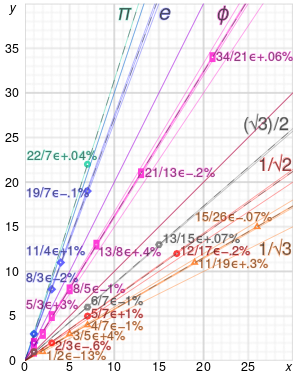هندسة الأعداد
هندسة الأعداد Geometry of numbers هي جزس من نظرية الأعداد يستخدم الهنسة لدراسة الأرقام الجبرية. فنمطياً، فإن حلقة من الأعداد الصحيحة الجبرية تـُرى على أنها شبكة في ودراسة تلك الشبكات يعطي معلومات أساسية حول الأعداد الجبرية.[1] هندسة الأعداد بدأها هرمان منكوڤسكي (1910).
هندسة الأعداد لها علاقة وثيقة مع حقول أخرى في الرياضيات، خصوصاً التحليل الدالّي والتقريب الديوفانتي، مسألة العثور على أعداد كسرية تقرِّب كمية غير نسبية.[2]
نتائج منكوڤسكي
افترض أن هي شبكة في الفضاء الإقليدي ذي بُعد و هي جسم محدب متناظر مركزياً. مبرهنة منكوڤسكي، والتي تُدعى أحياناً مبرهنة منكوڤسكي الأولى، تنص أنه إذا كان ، فإن تحتوي متجه غير صفري في .
القيمة الدنيا المتعاقبة تُعرَّف بأنها الـ inf للأعداد بحيث أن تحتوي متجهات مستقلة خطياً في . مبرهنة منكوڤسكي في القيم الدنيا المتعاقبة، أحياناً تُدعى مبرهنة منكوڤسكي الثانية، هي تقوية لمبرهنته الأولى وتنص أن[3]
أبحاث لاحقة في هندسة الأعداد
في 1930-1960 الأبحاث في هندسة الأعداد أجراها العديد من منظري الأعداد (منهم لويس موردل، هارولد داڤنپورت و كارل لودڤيگ زيگل). في السنوات الأخيرة، طور Lenstra, Brion, و Barvinok نظريات تباديلية تقوم بـِعـَدّ نقاط الشبكة في بعض الأجسام المحدبة.[4]
وتُطبَّق هندسة الأعداد على الطرق التي ظهرت نتيجة أعمال هرمان منكوڤسكي في وصف العلاقة بين المجموعات المحدبة والمشبك في الفضاء الرياضي ذو n بعدا.
تضع مبرهنة منكوڤسكي العلاقة بين المجموعات المحدبة المتناظرة وبين نقاط الأعداد الصحية، أو بين أي نقطة في المشبك وبين فضاء باناخ في الفضاء البعدي.
الهامش
- ^ MSC classification, 2010, available at http://www.ams.org/msc/msc2010.html, Classification 11HXX.
- ^ Schmidt's books. Grötschel et alii, Lovász et alii, Lovász.
- ^ Cassels (1971) p. 203
- ^ Grötschel et alii, Lovász et alii, Lovász, and Beck and Robins.
ببليوگرافيا
- Matthias Beck, Sinai Robins. Computing the continuous discretely: Integer-point enumeration in polyhedra, Undergraduate Texts in Mathematics, Springer, 2007.
- Enrico Bombieri; Vaaler, J. (Feb 1983). "On Siegel's lemma". Inventiones Mathematicae. 73 (1): 11–32. Bibcode:1983InMat..73...11B. doi:10.1007/BF01393823. S2CID 121274024.
- Enrico Bombieri & Walter Gubler (2006). Heights in Diophantine Geometry. Cambridge U. P.
- J. W. S. Cassels. An Introduction to the Geometry of Numbers. Springer Classics in Mathematics, Springer-Verlag 1997 (reprint of 1959 and 1971 Springer-Verlag editions).
- John Horton Conway and N. J. A. Sloane, Sphere Packings, Lattices and Groups, Springer-Verlag, NY, 3rd ed., 1998.
- R. J. Gardner, Geometric tomography, Cambridge University Press, New York, 1995. Second edition: 2006.
- P. M. Gruber, Convex and discrete geometry, Springer-Verlag, New York, 2007.
- P. M. Gruber, J. M. Wills (editors), Handbook of convex geometry. Vol. A. B, North-Holland, Amsterdam, 1993.
- M. Grötschel, Lovász, L., A. Schrijver: Geometric Algorithms and Combinatorial Optimization, Springer, 1988
- Hancock, Harris (1939). Development of the Minkowski Geometry of Numbers. Macmillan. (Republished in 1964 by Dover.)
- Edmund Hlawka, Johannes Schoißengeier, Rudolf Taschner. Geometric and Analytic Number Theory. Universitext. Springer-Verlag, 1991.
- Kalton, Nigel J.; Peck, N. Tenney; Roberts, James W. (1984), An F-space sampler, London Mathematical Society Lecture Note Series, 89, Cambridge: Cambridge University Press, pp. xii+240, ISBN 0-521-27585-7
- C. G. Lekkerkererker. Geometry of Numbers. Wolters-Noordhoff, North Holland, Wiley. 1969.
- Lenstra, A. K.; Lenstra, H. W. Jr.; Lovász, L. (1982). "Factoring polynomials with rational coefficients" (PDF). Mathematische Annalen. 261 (4): 515–534. doi:10.1007/BF01457454. hdl:1887/3810. MR 0682664. S2CID 5701340.
- Lovász, L.: An Algorithmic Theory of Numbers, Graphs, and Convexity, CBMS-NSF Regional Conference Series in Applied Mathematics 50, SIAM, Philadelphia, Pennsylvania, 1986
- Malyshev, A.V. (2001), "Geometry of numbers", in Hazewinkel, Michiel, Encyclopaedia of Mathematics, Kluwer Academic Publishers, ISBN 978-1556080104
- Minkowski, Hermann (1910), Geometrie der Zahlen, Leipzig and Berlin: R. G. Teubner, https://archive.org/details/geometriederzahl00minkrich, retrieved on 2016-02-28
- Wolfgang M. Schmidt. Diophantine approximation. Lecture Notes in Mathematics 785. Springer. (1980 [1996 with minor corrections])
- Schmidt, Wolfgang M. (1996). Diophantine approximations and Diophantine equations. Lecture Notes in Mathematics. Vol. 1467 (2nd ed.). Springer-Verlag. ISBN 3-540-54058-X. Zbl 0754.11020.
- Siegel, Carl Ludwig (1989). Lectures on the Geometry of Numbers. Springer-Verlag.
- Rolf Schneider, Convex bodies: the Brunn-Minkowski theory, Cambridge University Press, Cambridge, 1993.
- Anthony C. Thompson, Minkowski geometry, Cambridge University Press, Cambridge, 1996.
- Hermann Weyl. Theory of reduction for arithmetical equivalence . Trans. Amer. Math. Soc. 48 (1940) 126–164. DOI:10.1090/S0002-9947-1940-0002345-2
- Hermann Weyl. Theory of reduction for arithmetical equivalence. II . Trans. Amer. Math. Soc. 51 (1942) 203–231. DOI:10.2307/1989946
